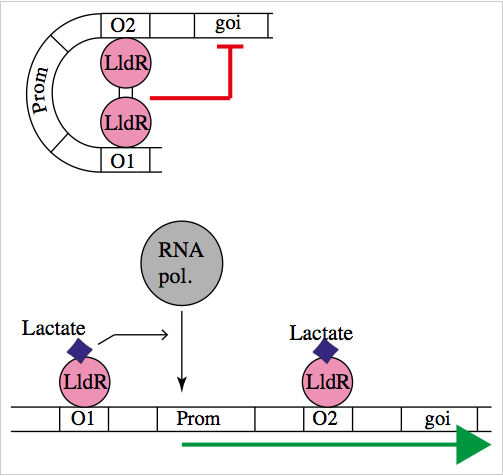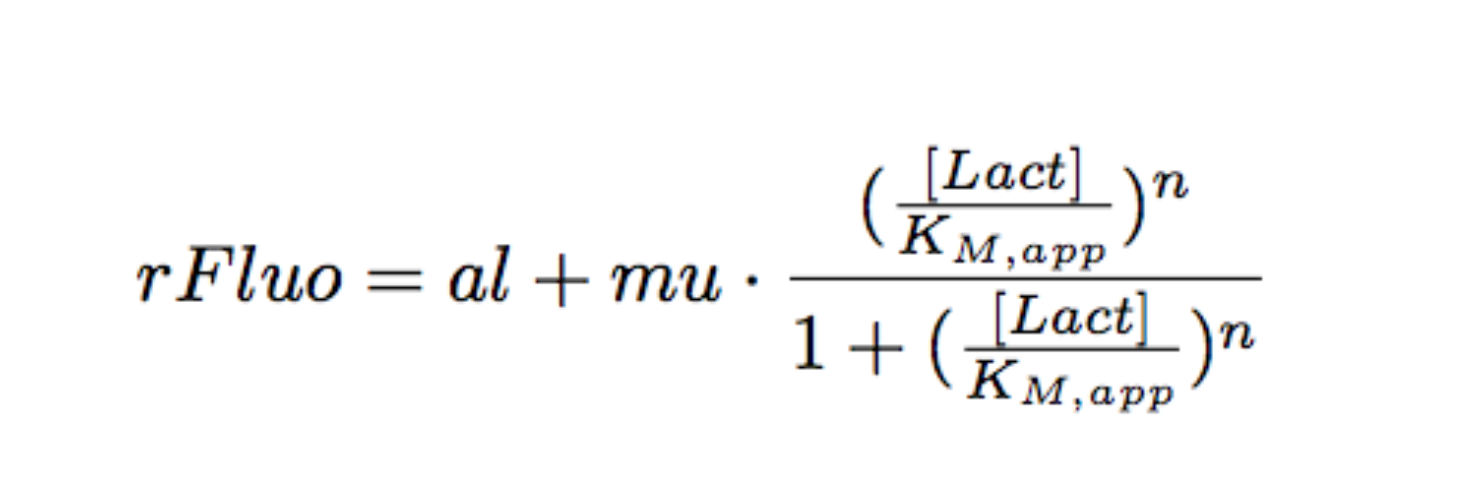Part:BBa_K1847008
lldRO1-J23117-lldRO2
Collection of promoters regulated by LldR.
Sequence and Features
- 10COMPATIBLE WITH RFC[10]
- 12INCOMPATIBLE WITH RFC[12]Illegal NheI site found at 78
Illegal NheI site found at 101 - 21COMPATIBLE WITH RFC[21]
- 23COMPATIBLE WITH RFC[23]
- 25COMPATIBLE WITH RFC[25]
- 1000COMPATIBLE WITH RFC[1000]
Usage and Biology
The natural promoter of LldR (Part:BBa_K822000) consists of two operators (O1 and O2) and a promoter which is intercalated between the operators. It regulates the expression of the lldPRD operon, and it is involved in L-lactate metabolism. This promoter is repressed by a dimer of LldR, possibly by forming a DNA loop that does not allow the RNA polymerase to bind to the promoter. LldR can also have a function as an activator [1]. The repression of the promoter can be removed by lactate.
Characterization of the promoter
We wanted to know how the promoter would respond to the lactate presence and how important is the architecture of the promoter in this response. For this regard, we built several promoters. Part:BBa_K1847002, Part:BBa_K1847003, Part:BBa_K1847004, Part:BBa_K1847005, Part:BBa_K1847006, Part:BBa_K1847007, Part:BBa_K1847008, and Part:BBa_K1847009.
Experimental Set-Up
Plasmids
To test our promoter we designed a plasmid containing the promoter with sfGFP in a medium copy plasmid pSEVA261 and transformed it into Escherichia coli TOP10. Then, we added a second plasmid containing lldR with a medium strong promoter (BBa_J23118) and a strong RBS (BBa_B0034) in pSEVA371 backbone. We expect LldR to repress the promoter and by the addition of lactate the production of GFP will start, as the repressor will be removed. We tried another set-up in which we added LldP into our LldR plasmid. LldP is an L-lactate permease which import L-lactate into the cell. In summary, we tried our system in three different conditions:
- Plasmid with the promoter and sfGFP in pSEVA261 + J23118-B0034-lldR in pSEVA371
- Plasmid with the promoter and sfGFP in pSEVA261 + J23114-B0032-lldP-lldR (LldP and LldR are under the control of the same promoter) in pSEVA371
- Plasmid with the promoter and sfGFP in pSEVA261 + J23114-B0032-lldP-lldR (LldP and LldR are under the control of the same promoter) in pSEVA371
Plate reader
E. coli TOP10 strains were grown overnight in Lysogeny Broth (LB) containing kanamycin (1 µ/mL) and chloramphenicol (0.36 µ/mL) at 37°C and 200 rpm. Cultures were diluted 1:50 in fresh LB with the corresponding antibiotic and transferred to a 96-well plate (200 µL/well). Cultures were grown for 90 min to arrive to exponential phase and then different concentrations of lactate were added. Samples were always made in triplicates and a blank of LB with the corresponding lactate concentration was done. During 7 h the absorbance at OD600 and fluorescence (excitation 488 nm and emission 530 nm) were measured with intervals of 7 min. The plate was always kept at 37°C. We calculated dose-response curves from the exponential phase of the bacteria.
Modeling
Each experimental data set was fitted to a Hill function using the Least Absolute Residual method (Fitting Toolbox in MatLab).
Where:
- al: leakiness in µM/min
- mu: constant in µM/min
- Km: half-maximum effective concentration (a representation of sensitivity) in µM
- n: Hill coefficient (a representation of cooperativity), unitless
| J23118-B0034-lldR | J23118-B0034-lldP-lldR | J23114-B0032-lldP-lldR | |
|---|---|---|---|
| Coefficient values | K=1075 (889.5, 1261) | K=1751 (918.5, 2584) | K=337.7 (152.4, 522.9) |
| al = 479.3 (-142.2, 1101) | al = 550 (-1635, 2735) | al = 3444 (2571, 4317) | |
| mu = 7311 (6583, 8039) | mu = 1.318e+04 (1.03e+04, 1.607e+04) | mu = 4886 (3817, 5954) | |
| n1 = 0.8499 (0.1814, 1.518) | n1 = 0.9388 (0.5614, 1.316) | n1 = 1.09 (0.531, 1.649) | |
| Goodness to fit | sse: 4.2545e+07 | sse: 6.4285e+08 | sse: 2.7027e+08 |
| rsquare: 0.9964 | rsquare: 0.9879 | rsquare: 0.9743 | |
| fe: 7 | dfe: 7 | dfe: 7 | |
| adjrsquare: 0.9949 | adjrsquare: 0.9828 | adjrsquare: 0.9633 | |
| rmse: 2.4653e+03 | rmse: 9.5831e+03 | rmse: 6.2137e+03 |
As you can see from the graphs, activation with only LldR is lower than with LldP-LldR. Also, the sample with LldP-LldR with a stronger promoter achieves higher fluorescence levels. We believe that this is due to the fact that more molecules of LldP are produced and therefore more lactate can enter inside the cell. Just as a qualitative example, J23118-B0034-lldR has half of the maximum fluorescence than J23118-B0034-lldP-lldR. When comparing J23114-B0034-lldP-lldR and J23118-B0034-lldP-lldR, we can see that J23114-B0034-lldP-lldR has more leakiness, which we think is due to its low expression, and therefore it cannot repress the gene properly.
In the figure below, you can see a comparison between the wild-type promoter and our designed promoters maintaining the same structure than the aid-type but changing the promoter for an Anderson promoter. LldR is required for the repression of the promoter in the absence of lactate, and it is also necessary for the activation in the presence of lactate.

References
- J Bacteriol. 2008 Apr; 190(8): 2997–3005.
| None |





